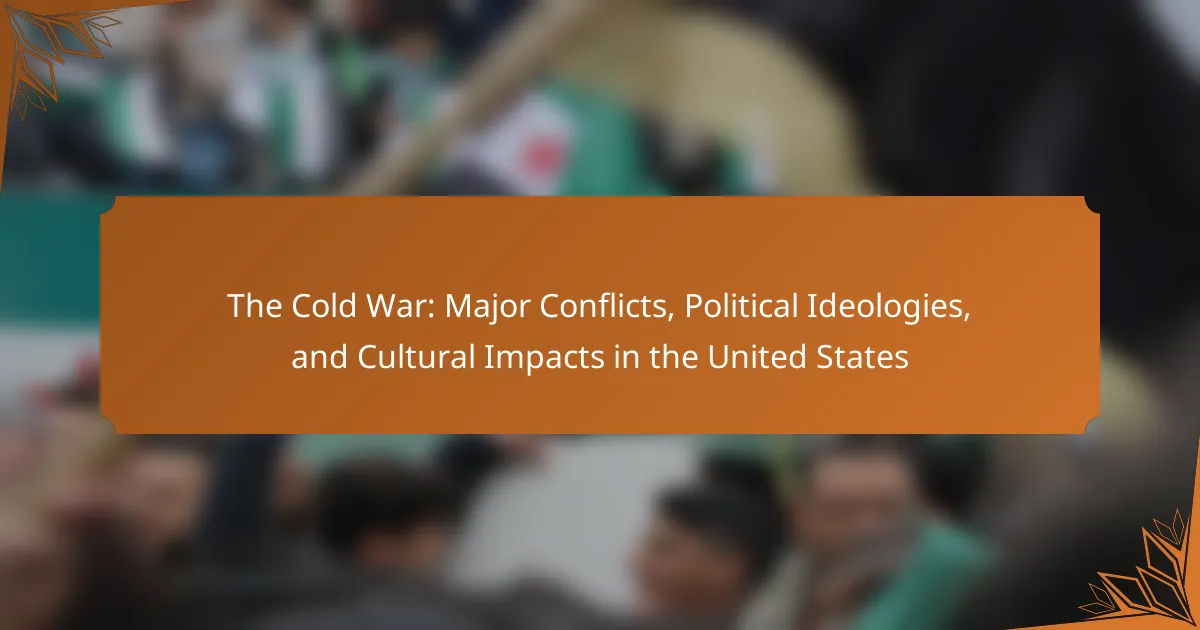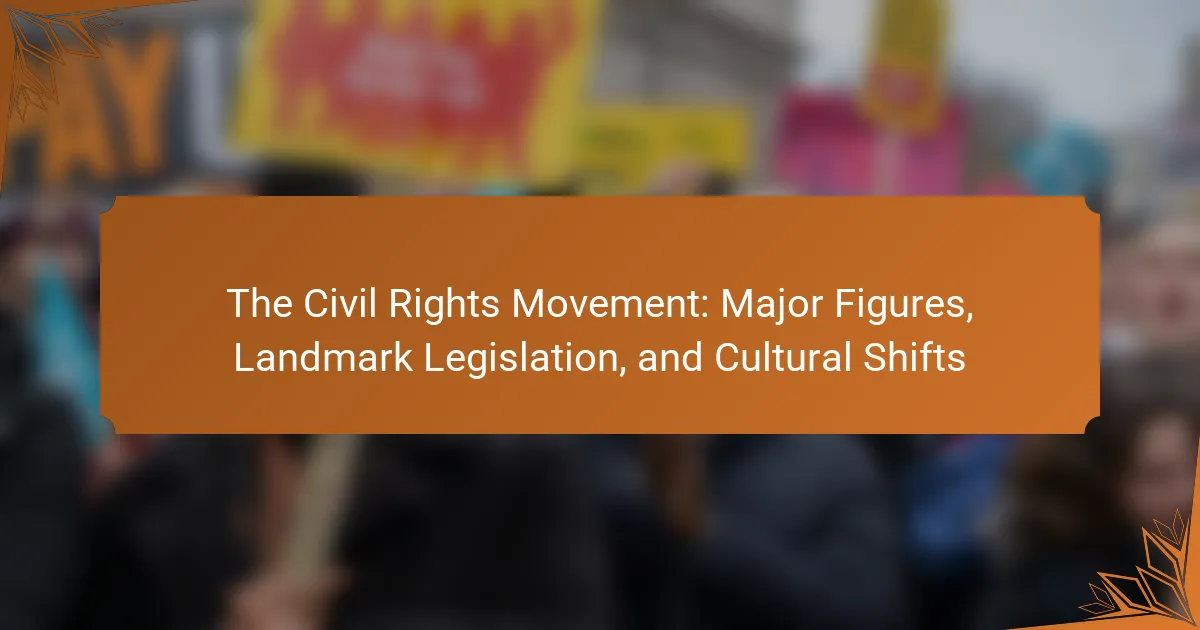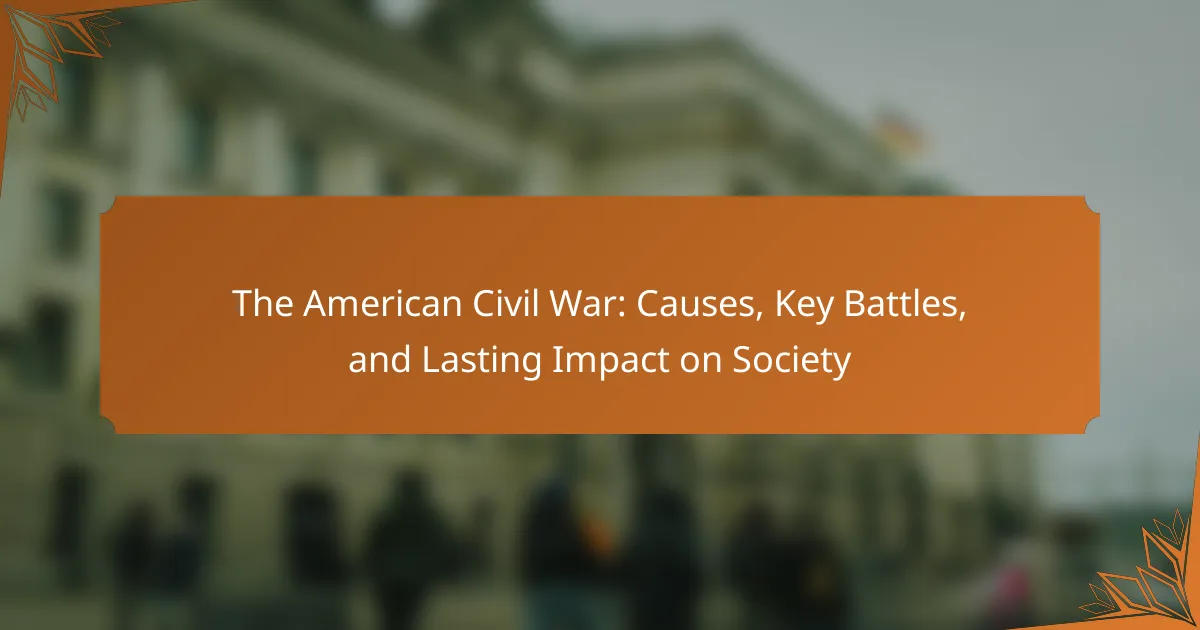The Cold War refers to the geopolitical tension between the Soviet Union and the United States from approximately 1947 to 1991, characterized by ideological conflict, military rivalry, and proxy wars. This period had significant implications for global politics, economics, and culture, leading to the establishment of military alliances such as NATO and the Warsaw Pact, as well as a nuclear arms race. The ideological divide between capitalism, represented by the United States, and communism, championed by the Soviet Union, shaped foreign policies and domestic sentiments, including anti-communism and civil rights movements. Cultural impacts in the United States were profound, influencing popular media, youth culture, and national identity during the mid-20th century, while events like the Cuban Missile Crisis highlighted the escalating tensions rooted in these competing ideologies.
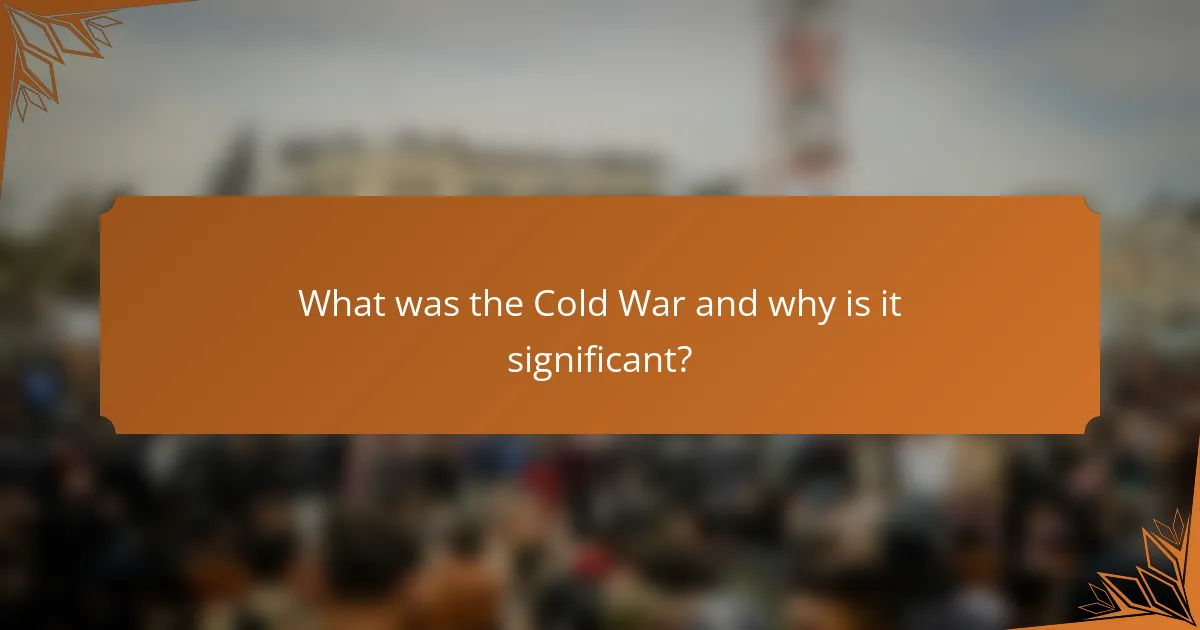
What was the Cold War and why is it significant?
The Cold War was a geopolitical tension between the Soviet Union and the United States from roughly 1947 to 1991. This period was characterized by ideological conflict, military rivalry, and a series of proxy wars. The significance of the Cold War lies in its profound impact on global politics, economics, and culture. It led to the formation of military alliances such as NATO and the Warsaw Pact. The arms race during this time resulted in the development of nuclear weapons. The Cold War also influenced domestic policies in the U.S., including anti-communism and civil rights movements. Ultimately, the Cold War shaped the modern world order and contributed to the eventual dissolution of the Soviet Union in 1991.
What were the main causes of the Cold War?
The main causes of the Cold War were ideological differences, geopolitical tensions, and historical conflicts. The United States and the Soviet Union had opposing political ideologies. The U.S. promoted capitalism and democracy, while the Soviet Union advocated for communism. The end of World War II left a power vacuum in Europe. This led to competition for influence between the two superpowers. The Truman Doctrine established U.S. policy to contain communism. The Marshall Plan aimed to rebuild European economies to prevent the spread of communism. The Berlin Blockade in 1948 intensified tensions. Events like the Korean War further escalated the conflict. These factors collectively contributed to the prolonged rivalry known as the Cold War.
How did ideological differences contribute to the Cold War?
Ideological differences between the United States and the Soviet Union significantly contributed to the Cold War. The U.S. promoted capitalism and democracy, while the Soviet Union advocated for communism and a one-party state. These opposing ideologies created mutual distrust and hostility. The U.S. viewed communism as a threat to individual freedoms and global stability. Conversely, the Soviet Union perceived capitalism as imperialistic and exploitative. This ideological divide fueled competition in military, technological, and cultural arenas. Events like the Cuban Missile Crisis highlighted the dangers of these ideological tensions. Ultimately, these differences shaped foreign policies and led to prolonged conflicts.
What role did historical events play in initiating the Cold War?
Historical events significantly contributed to the initiation of the Cold War. The end of World War II in 1945 marked a power vacuum in Europe. The United States and the Soviet Union emerged as superpowers with conflicting ideologies. The division of Germany and the establishment of the Iron Curtain symbolized this divide. The Truman Doctrine in 1947 aimed to contain communism, further escalating tensions. The Marshall Plan, also in 1947, sought to rebuild Europe but was viewed by the Soviets as a threat. The Berlin Blockade in 1948 exemplified the growing animosity. These events created a climate of distrust and competition, laying the groundwork for the Cold War.
What were the key conflicts during the Cold War?
The key conflicts during the Cold War included the Korean War, the Vietnam War, and the Cuban Missile Crisis. The Korean War lasted from 1950 to 1953 and was a direct military confrontation between North Korea and South Korea, with the U.S. supporting South Korea. The Vietnam War occurred from the late 1950s until 1975, involving North Vietnam and South Vietnam, with significant U.S. military involvement to prevent the spread of communism. The Cuban Missile Crisis in 1962 was a 13-day confrontation between the United States and the Soviet Union over Soviet missiles in Cuba, marking a peak in Cold War tensions. Each of these conflicts exemplified the ideological struggle between capitalism and communism during the Cold War era.
What were the major military confrontations of the Cold War?
The major military confrontations of the Cold War included the Korean War, the Vietnam War, and the Soviet-Afghan War. The Korean War took place from 1950 to 1953. It involved North Korea, supported by China and the Soviet Union, against South Korea, backed by United Nations forces led by the United States. The Vietnam War occurred from the late 1950s to 1975. It was a conflict between North Vietnam, supported by its communist allies, and South Vietnam, backed by the U.S. and other anti-communist nations. The Soviet-Afghan War lasted from 1979 to 1989. Soviet forces intervened in Afghanistan to support a communist government against insurgent groups. Each of these confrontations exemplified the ideological struggle between communism and capitalism during the Cold War.
How did proxy wars shape the Cold War landscape?
Proxy wars significantly influenced the Cold War landscape by serving as battlegrounds for U.S. and Soviet interests. These conflicts occurred in various regions, including Korea, Vietnam, and Afghanistan. They allowed both superpowers to extend their influence without direct military confrontation. For instance, the Korean War (1950-1953) solidified the division of Korea and showcased the ideological struggle between communism and capitalism. The Vietnam War (1955-1975) further entrenched U.S. involvement in Southeast Asia and demonstrated the limits of American military power. Additionally, the Soviet invasion of Afghanistan (1979-1989) drained Soviet resources and contributed to its eventual collapse. Proxy wars thus shaped alliances, military strategies, and public perceptions during the Cold War era.
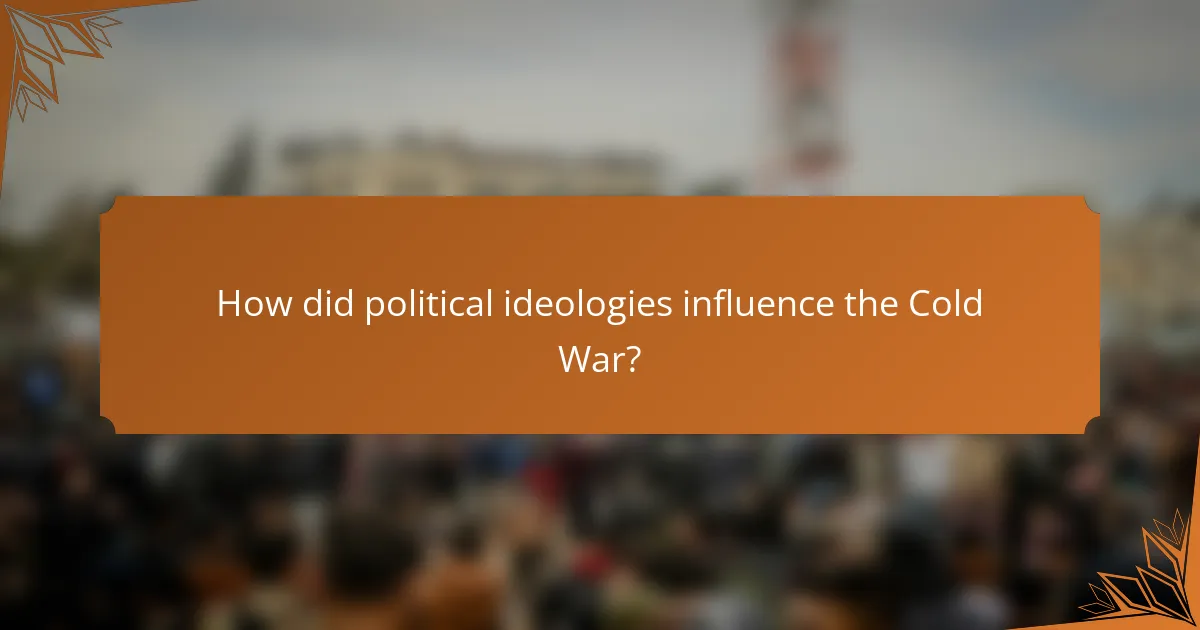
How did political ideologies influence the Cold War?
Political ideologies significantly influenced the Cold War by creating a binary conflict between capitalism and communism. The United States, advocating capitalism, sought to contain the spread of communism, which was championed by the Soviet Union. This ideological clash shaped foreign policies, such as the Truman Doctrine, which aimed to support countries resisting communism. The ideological divide also fueled military alliances, including NATO and the Warsaw Pact, solidifying the global divide. Propaganda from both sides emphasized the moral superiority of their respective ideologies. The arms race and space race were also driven by the desire to demonstrate ideological dominance. Key events, like the Cuban Missile Crisis, illustrated how ideology could escalate tensions. Overall, political ideologies were central to the motivations and actions of both superpowers during the Cold War.
What were the primary ideologies at play during the Cold War?
The primary ideologies at play during the Cold War were capitalism and communism. Capitalism, led by the United States, emphasized free markets and private ownership. It advocated for individual freedoms and democratic governance. Communism, led by the Soviet Union, promoted state ownership and a classless society. It aimed to eliminate private property and establish a one-party state. The ideological conflict between these two systems fueled global tensions. Events such as the Cuban Missile Crisis and the Vietnam War exemplified this struggle. The competition also extended to arms races and space exploration. These ideologies shaped foreign policies and domestic agendas for decades.
How did capitalism and communism clash during the Cold War?
Capitalism and communism clashed during the Cold War through ideological, political, and military confrontations. Capitalism, led by the United States, emphasized free markets and individual liberties. In contrast, communism, represented by the Soviet Union, promoted state control and collective ownership. The ideological divide fueled tensions, leading to events like the Korean War and the Cuban Missile Crisis. The arms race between the two superpowers showcased their military rivalry. Propaganda campaigns further intensified the conflict, with each side portraying the other as a threat. Additionally, proxy wars in various regions highlighted the global struggle between these two ideologies. The clash ultimately defined international relations during the Cold War era.
What role did nationalism play in Cold War politics?
Nationalism significantly influenced Cold War politics by shaping the identities and policies of newly independent nations. During the Cold War, many countries in Asia, Africa, and Latin America sought independence from colonial powers. Nationalist movements often aligned with either the United States or the Soviet Union, seeking support for their causes. For example, leaders like Kwame Nkrumah in Ghana and Ho Chi Minh in Vietnam utilized nationalism to garner support against colonialism and imperialism. The U.S. aimed to contain communism by promoting capitalist nationalism, while the USSR supported socialist nationalism. This competition often led to proxy wars, as seen in Korea and Vietnam. Nationalism thus acted as a catalyst for global conflicts and shaped the geopolitical landscape of the Cold War era.
How did political strategies evolve throughout the Cold War?
Political strategies evolved significantly throughout the Cold War. Initially, the United States and the Soviet Union engaged in direct military confrontation and ideological competition. The U.S. adopted a policy of containment to prevent the spread of communism. This strategy was evident in the Truman Doctrine and the Marshall Plan, which aimed to support countries resisting Soviet influence.
As the Cold War progressed, the strategies shifted towards proxy wars. The U.S. and USSR supported opposing sides in conflicts such as the Korean War and the Vietnam War. This approach allowed both superpowers to exert influence without direct confrontation.
In the later stages, détente emerged as a key strategy. This involved easing tensions through diplomacy and arms control agreements, such as the Strategic Arms Limitation Talks (SALT). The U.S. and Soviet leaders engaged in summits to foster communication and reduce the risk of nuclear conflict.
By the end of the Cold War, political strategies included a focus on economic and cultural influence. The U.S. promoted democracy and capitalism in Eastern Europe, which contributed to the collapse of communist regimes. This evolution reflects the changing dynamics and complexities of global politics during the Cold War era.
What were the key diplomatic strategies used by the United States?
The key diplomatic strategies used by the United States during the Cold War included containment, deterrence, and diplomacy through alliances. Containment aimed to prevent the spread of communism, as articulated in the Truman Doctrine. The strategy of deterrence involved maintaining a strong military presence to discourage Soviet aggression. Alliances such as NATO were formed to unify Western nations against the Soviet threat. Economic aid programs like the Marshall Plan helped rebuild Europe and stabilize governments. These strategies were essential in shaping U.S. foreign policy during the Cold War era.
How did the concept of containment shape U.S. foreign policy?
The concept of containment significantly shaped U.S. foreign policy during the Cold War. Containment aimed to prevent the spread of communism globally. It was articulated by George Kennan in 1947. The policy influenced U.S. actions in various conflicts, including the Korean War and the Vietnam War. For example, the U.S. intervened in Korea to stop North Korean aggression. This intervention was based on the belief that communism needed to be contained to protect democracy. Additionally, containment led to the establishment of military alliances like NATO. It also justified U.S. support for anti-communist regimes worldwide. Overall, containment defined U.S. strategies and actions throughout the Cold War era.

What were the cultural impacts of the Cold War in the United States?
The cultural impacts of the Cold War in the United States included heightened anti-communist sentiment and increased government propaganda. This era saw the rise of McCarthyism, which led to the persecution of perceived communists in various sectors. Popular culture reflected these tensions through films, literature, and music that often depicted themes of espionage and nuclear threat. The fear of nuclear war influenced art and literature, leading to dystopian narratives. The Cold War also spurred the growth of youth culture, particularly in the 1960s, as young Americans reacted against the prevailing political climate. The space race inspired a sense of national pride and technological advancement, which permeated popular media. Overall, the Cold War significantly shaped American identity and cultural expressions during the mid-20th century.
How did the Cold War influence American society and culture?
The Cold War significantly influenced American society and culture by fostering a climate of fear and suspicion. This period saw the rise of anti-communist sentiment, which permeated various aspects of life. The Red Scare led to the persecution of suspected communists, impacting civil liberties. The government conducted extensive propaganda campaigns to promote American values and capitalism. Additionally, the space race fueled technological advancements and educational reforms. Cultural expressions, such as literature and film, often reflected the anxieties of the era. For example, films like “Dr. Strangelove” satirized the absurdity of nuclear war. Overall, the Cold War shaped a collective identity centered on patriotism and ideological conflict.
What role did propaganda play in shaping public perception?
Propaganda played a critical role in shaping public perception during the Cold War. It was used by both the United States and the Soviet Union to influence opinions and beliefs. The U.S. government employed propaganda to promote democracy and capitalism. This included films, literature, and advertisements that highlighted the benefits of the American way of life.
Conversely, the Soviet Union utilized propaganda to portray communism as superior. They emphasized the supposed failures of capitalism and the benefits of a collectivist society. Propaganda campaigns often targeted specific groups to incite fear or loyalty. For example, anti-communist propaganda aimed to unify Americans against perceived threats.
Historical events, such as the Red Scare, exemplified the impact of propaganda on public perception. Fear of communism led to widespread suspicion and conformity in American society. The media played a significant role in disseminating these messages, shaping public discourse.
Overall, propaganda was a powerful tool in both promoting ideologies and molding societal attitudes during the Cold War.
How did the Cold War affect art and literature in America?
The Cold War significantly influenced art and literature in America. Artists and writers responded to the political climate by exploring themes of fear, paranoia, and identity. The rise of abstract expressionism in visual art mirrored the complexities of the era. Notable figures like Jackson Pollock and Mark Rothko used their work to express emotional depth in uncertain times. Literature also reflected Cold War tensions. Authors like Kurt Vonnegut and George Orwell examined dystopian futures and totalitarianism. The Red Scare prompted many artists to self-censor or adopt cryptic styles to avoid persecution. This period fostered a unique cultural landscape that interrogated American values and global politics. Overall, the Cold War catalyzed a profound evolution in American artistic expression.
What lasting effects did the Cold War have on American identity?
The Cold War significantly shaped American identity by fostering a sense of nationalism and anti-communism. This period heightened the importance of capitalism and democracy as core American values. The fear of communism influenced domestic policies and public sentiment. It led to the creation of institutions like the CIA and NSA, which emphasized national security. The Cold War also spurred technological advancements, particularly in aerospace and military technology. Events like the moon landing in 1969 became symbols of American exceptionalism. Cultural expressions, including literature and film, reflected Cold War anxieties and ideologies. Overall, the Cold War’s legacy continues to influence American political and social dynamics today.
How did the Cold War shape views on patriotism and dissent?
The Cold War significantly influenced views on patriotism and dissent in the United States. During this period, patriotism became closely associated with anti-communism. Citizens were encouraged to demonstrate loyalty to the nation and its democratic values. Dissent was often perceived as unpatriotic or even treasonous. The Red Scare intensified fears of communist infiltration. This led to government actions against perceived dissidents, such as the McCarthy hearings. Many individuals faced social ostracism for opposing mainstream views. The cultural narrative promoted conformity over dissent. Thus, the Cold War era reshaped the understanding of what it meant to be patriotic in America.
What are the implications of Cold War culture in contemporary America?
Cold War culture significantly influences contemporary America. It manifests through ongoing political polarization and national security concerns. The legacy of anti-communism shapes current political rhetoric. Fear of external threats persists in public policy and media. Cultural references from the Cold War era remain prevalent in films and literature. The arms race mentality informs modern military strategies and defense spending. Historical events from the Cold War continue to impact international relations. The emphasis on individualism and capitalism, rooted in Cold War ideology, persists in American society.
What lessons can be learned from the Cold War era?
The Cold War era teaches the importance of diplomacy and communication in international relations. It highlighted the dangers of nuclear proliferation and the need for arms control agreements. The Cuban Missile Crisis exemplified how miscommunication could escalate tensions dangerously. Additionally, the era demonstrated the impact of ideological conflicts on global politics. The competition between capitalism and communism influenced many nations’ political systems. Moreover, it showed the significance of alliances, as seen in NATO and the Warsaw Pact. Lastly, the Cold War emphasized the role of propaganda in shaping public perception and policy. These lessons remain relevant in today’s geopolitical landscape.
How can understanding the Cold War inform current geopolitical strategies?
Understanding the Cold War can inform current geopolitical strategies by highlighting the importance of ideological conflict. The Cold War was characterized by the rivalry between capitalism and communism. This historical context shows how ideology can shape national policies and alliances.
Current geopolitical tensions often reflect similar ideological divides. For example, the competition between democratic and authoritarian regimes is prevalent today. Lessons from the Cold War emphasize the need for strategic alliances based on shared values.
Additionally, the Cold War demonstrated the significance of intelligence and information warfare. Modern strategies increasingly rely on cyber capabilities and information campaigns. The historical precedent of proxy wars during the Cold War also informs today’s approach to regional conflicts.
Recognizing these patterns helps policymakers anticipate challenges and adapt strategies effectively. Understanding the past equips leaders with insights for navigating contemporary global dynamics.
What are the best practices for promoting peace in a polarized world?
Promoting peace in a polarized world requires active dialogue and understanding. Engaging in open conversations helps bridge divides. Encouraging empathy allows individuals to see different perspectives. Building coalitions fosters collaboration among diverse groups. Practicing nonviolent communication reduces hostility. Supporting community initiatives strengthens local ties. Educating about conflict resolution equips individuals with necessary skills. Lastly, advocating for inclusive policies promotes equity and justice. These practices can effectively reduce polarization and enhance peace.
The Cold War was a period of geopolitical tension between the Soviet Union and the United States from 1947 to 1991, marked by ideological conflict, military rivalry, and significant proxy wars. This article explores the main causes of the Cold War, including ideological differences and historical events, as well as key conflicts such as the Korean War and the Cuban Missile Crisis. Additionally, it examines the cultural impacts of the Cold War on American society, including the rise of anti-communism and the influence of propaganda. The article also discusses the evolution of political strategies and the lasting effects of the Cold War on American identity and contemporary geopolitical dynamics.
